|

Changing the face of dance
Ruwini JAYAWARDANA
His name is synonymous with dance and together with his spouse,
Upuli, they bring magic on stage. His ingenuity and passion for the art
helped carve productions like the globally acclaimed Thala series and
the Sigiriya ballet.

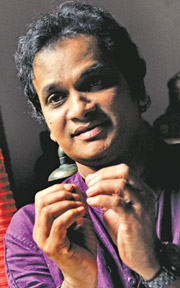 |
|
Channa Wijewardena. Picture by Saman
Sri Wedage |
Proving his diversity further, he brought local artistes from the
reel onto the live stage. The Ridee Reyak shows become so popular that
it was a much looked forward to event in the arts calendar.
"There are a few small changes we do to the production but we always
make sure that the tradition is preserved. It is essential to give a
correct view. Therefore we have to change certain stances," says the
virtuoso dancer cum choreographer who spurred aspiring youths to
revolutionize the Sri Lankan dance arena with his Channa - Upuli
Performing Arts, Foundation. The dance troupe's movements, gestures,
rhythms and costumes have held audiences spellbound for over three
decades
Our 'Encounter of the Week', Channa Wijewardena, the name which
blends with Sri Lankan dance, is one amongst a few who taken the
country's dance traditions to international stage.
Q: You once commented that our traditional dance forms are not
suited to the stage.
A: When we take rituals like Kohomba Kankariya, Dewol Maduwa
and Sabaragamuwa dances, they were not designed for the stage. It is a
different eye view because it is normally done on the floor. Therefore
we have to project the movement the correct way.
We have to change the posture of the dancer on stage. We have to make
subtle changes just to preserve the tradition and maintain the real
beauty of the dance. We also have to adapt to the light systems that we
have in theatres. Nelum Pokuna is in the same category as Sydney Opera
House. Our dancers delighted in performing there.
Q: From where do you draw your inspiration?
A: Traditions, the spiritual feel and the discipline of a
dancer. I do a lot of dances from temple paintings. I choreographed the
dance for the opening of Nelum Pokuna based on those aspects. It showed
heaven on stage.
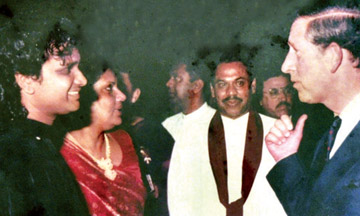 |
|
Channa with Prince Charles, former
president Chandrika Bandaranaike Kumaratunga and present
President Mahinda Rajapaksa |
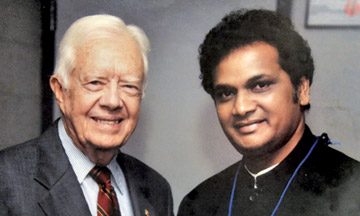 |
|
Channa with
former US President Jimmy Carter |
|
 |
|
Moments
from Thala 2012 Pictures by Sagara Lakmal de Mel |
When we take dance and movements there are two aspects that we have
to consider.
There is some floor pathway which are the designs that you make on
the floor. We play around with energy. The next is the air pathway which
is the movement we do in space.
Even the tradition has a beautiful bodyline so you have to be very
precise in the movement. There is a movement behind the traditional step
which has to be analyzed and given to the dancer.
Q: It has been said that both the traditional and non-dance
audiences are drawn to your work. In your opinion what is it about your
dances that attract them?
A: It is the energy. Colour has energy. The speed of light is
299792.458 km/s. Every colour has the energy to captivate the audience.
We dance to their hearts.
Human beings naturally love to dance from the time they take their
first steps. Dance is in our system. The audience gets into the
spiritual power of the dance.
A lot of people are copying our work and losing themselves. There is
a history behind every movement and every design in the costume. I
recently saw a troupe who had carbon copied a set of my costumes and
doing the wrong movements in it. A costume is designed for certain
movements. When you copy a costume and do the wrong movements, it looks
totally out!
Q: You did the Sigiriya ballet which is dubbed the 'first
genuine Sri Lankan ballet'.
A: That is what Professor Carlo Fonseka called it because
there were no songs in it. It was total dance drama. I have been a part
of Karadiya or Nala Damayanthi. Since I have danced in those productions
it is easy for me not to take anything from them. My teachers were
Chitrasena and Vajira. I was inspired into dance theatre by them. They
were the doyens behind theatre dance and the discipline comes from them.
Sigiriya is a very powerful ballet. It brought tears in the
audience's eyes for Kashyapa. The driving force behind this play is
guilt.
Q: What is the basis of Thala 2012 ?
A: Thala 2012 was an outcome of our visit to the States. A
party from Huston who had seen the show phoned Colombo and said that
they are lucky to have productions like this in the country. The other
party in turn had said that the troupe does not perform in Sri Lanka.
They made a request for us to stage the show at the Nelum Pokuna.
Each Thala embodies new items. Until the 2012 production I was
staging 'Thala 2008'. We ventured more onto the spiritual lines in
'Thala 2012' and used less ornaments because I wanted the movements to
play the main role in dance.
Q: You also spearhead the Ridee Reyak series. You work with
actors rather than professional dancers in this event. How different is
it staging Ridee Reyak from your other dance productions?
A: Ridee Reyak completed its ninth chapter recently. The
concept of Ridee Reyak is to collect funds for the insurance of
artistes. Our stars have a big fan following. Sangeetha Weeraratne and
Yashodha Wimaladharma backed me in my concept. I used the stars first in
the Maliniye show and the team got a big shock when I told them that I
was going use the stars for the dance performances.
However I knew that I could pull it off because some of the artistes
like Malini, Dilhani and Sangeetha were learning from me.Every person
has a movement within themselves. The choreographer should detect the
movements that they are capable of. For example I know what movements
Ravindra Randeniya is capable of.
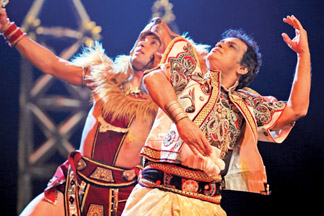 |
|
The
Sigiriya ballet |
Similarly I note what movements Suraj Mapa has the ability to
perform. Therefore I am not going to give what Suraj can do to Ravindra
and vice versa. They have their own capacity of movements.
Due to the artistes' heavy schedules there is lack of time for
rehearsals. If we are coming down in Ridee Reyak it is due to that.
Unlike in films you need to practise for this kind of performances.
In cinema there are stars that have done one film and become the best
actor or actress in Sri Lanka. You can never do that in dancing.
You have to work really hard for long spans to become a dancer. You
should know what movement is and movement consists of time, space and
energy. You should know what designs to make according to those. Without
knowing the fundamentals behind movement you cannot create a movement.
You can borrow steps from here and there, gather it and put it out.
That is not a creation.
To create a movement you need to know the anatomy of the system, the
muscles that you are using, how the muscles and joints move. We teach
all that to our dancers including how to do their make up, how to move,
fall, get up, expressions, different ways of leaping etc. Steps come
second to movement.
It is similar to a person flying a kite. The person is the tradition,
the kite is the performer and the string is performing arts. The more
powerful your performing ability is the higher your kite will sore. You
cannot send the string higher if there is no person gripping it.
Therefore tradition plays the key role.
Q: How do you prepare for the vulnerability that your work
demands, as a dancer and as a choreographer?
A: To be a choreographer you have to be a dancer and a good
teacher. Then you need to know the technical aspects behind the dance
such as lighting and the camera angles.
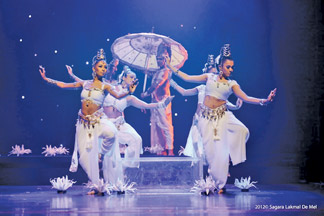 |
|
A scene
from Thala 2012 |
A lot of problems that we face in Sri Lanka is because they just draw
a figure and sketch a costume on that figure but when you take dance
there are a lot of angles to be concerned about because a dancer moves
all round the area.
The costume has to be designed for that. You have to give the exact
line of your movement to the audience whichever way you turn.
A teacher has to remember that when he or she gets a dancer, he or
she gets the most valuable time and age span in the child. Discipline
and etiquette has to be maintained in the child because when the dancer
go overseas and behave, they will know if he or she is refined or not.
While carrying the art they also carry the personality of the country
with them. Dancers should have knowledge about their country because
they get invited to dinners while on their tours. They do not know with
whom they will be seated but they should know how to get into
conversation and through the conversation the other person will judge
the speaker's country.
Q: What compels you to keep choreographing?
A: I am always looking out for something new. I never look
back at old productions and compile the new one. Life is all about
experiencing new things. I even change the interior setup of my house
every three or four months.
Any human being likes changes. Change means blooming yourself like a
flower. You are open to more aspects.
Q: You have gotten the chance to showcase your work in many
internationally known venues and festivals. Any special events which you
consider as the highlights of your career?
A: We performed in Chicago once and Jimmy Carter was among the
audience.
 He said he wants to meet the Indian group. We corrected him saying we
are from Sri Lanka. He came backstage and spoke to us. He said he wants to meet the Indian group. We corrected him saying we
are from Sri Lanka. He came backstage and spoke to us.
We also performed for Prince Charles on his visit to Sri Lanka. He
too expressed his desire to speak to us. He said that he now knows where
Sri Lanka stands because through dance he saw the development of our
country.
He realized that this is a refined country. I have also met Sai Baba
and he conjured a gold pendent out of thin air for me.
We got the opportunity to open door for Sri Lanka at the Sydney Opera
House. They requested to see us performance before granting us
permission. Even India had not been given a chance to perform there
then. We sent them a CD and they were so impresses that they gave us
immediate access.
Q: Why donít you choreograph for films?
A: I am currently choreographing for Naveen Gunaratneís
Siddhartha. I love the theme because it is very spiritual. I have worked
a lot with Naveen and we made the Sama ballet together five years ago. I
am not into commercial films but more into artistic films.
I have also done some music videos but the problem is that some
people go to the set and decide on the camera angles and lighting. I
prefer pre-planning, have some sort of breakdown and then start
choreographing.
When there is dance there is a lot of synchronizing. You just canít
go to the sets and do it. That is the reason why there are a lot of
failures in our dance choreographies. When I invent a movement, it takes
time for the dancer to grasp it.
Q: What else are you working on?
A: I am hoping to do a ballet on Gautama Siddhartha with the
Light of Asia Foundation. We hope to stage it during Poson.
There are a lot of talented young troupes coming up. People who hire
us and other troupes should have a way to see them perform. They should
be given an opportunity to showcase their talents to the public. |



